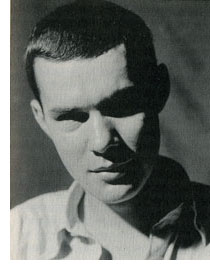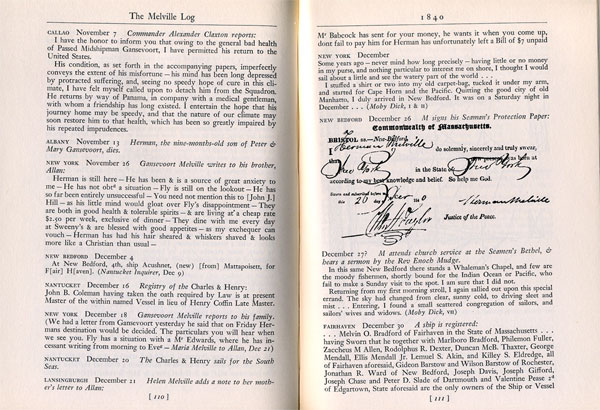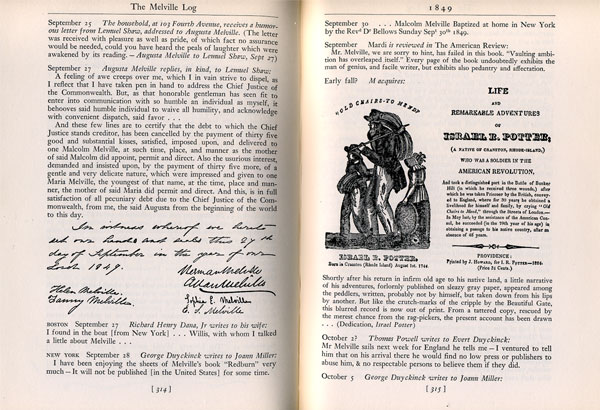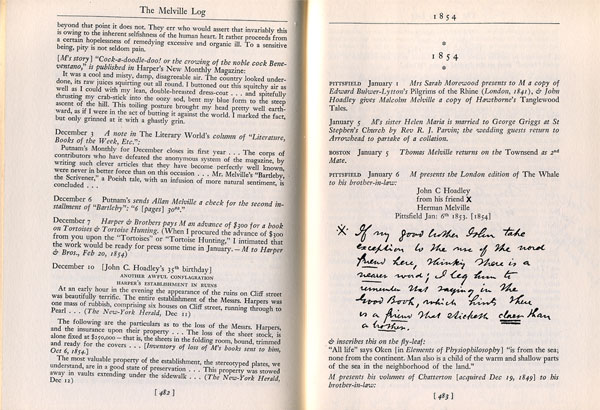There’s something about the work of Herman Melville that brings out the unexpected in his readers. Example can be drawn almost at random. Call Me Ishmael, the poet Charles Olson’s lyrical little book on Moby-Dick, is as much a meditation on patrimony, artistic and otherwise, as it is about Melville. When the U. S. government locked him up at Ellis Island, the Trinidadian socialist C. L. R. James took the opportunity to move into literary criticism, writing Mariners, Renegades and Castaways: The Story of Herman Melville and the World We Live In, in which he found Melville a sympathetic audience for his argument against state capitalism. Maurice Sendak, best known for Where the Wild Things Are, created semi-pornographic illustrations for an edition of Pierre, Melville’s little-known novel about incest and doubt. Claire Denis turned the comparatively staid Billy Budd into Beau Travail, a sun-dazed film about the French Foreign Legion that culminates in one of the most desparate dance numbers ever. Paul Metcalf, Melville’s great-grandson, smashed together Columbus, teratology, the Bobby Greenlease kidnapping & murder of 1953, and his family’s misgivings about their ancestor to form Genoa, a collage novel.
I set off to write about Metcalf and his unclassifiable books – most of them textual collages made of appropriated writing. Metcalf’s writing is perhaps worth paying attention to in light of electronic media, thoughhere’s precious little about him on the Internet (an interview, an obituary). Thinking about Metcalf’s work, however, I found myself sidetracked: when asked about the inspirations for his textual collages, he pointed to another work on Melville, Jay Leyda’s The Melville Log. I’ll return to Metcalf some other time; he’s not going anywhere.
The Melville Log, though. This is a book that might be just as weird as anything else that Melville ever inspired. It’s also instructive for thinking about how composition in the age of the ubiquitous archive could work. First, a bit of backstory: though Melville was prominent early in his career, he’d faded entirely from the American consciousness by 1920, when Billy Budd was discovered and Moby-Dick was discovered to be the Great American Novel of the nineteenth century. Literary scholars went to work scrutinizing Melville’s life and work; Jay Leyda arrived on the scene in the 1940s, having missed the main boom, but being a big part of a post-war boomlet. In 1951, after years of work, he published The Melville Log, a compilation of first-hand sources about Melville’s life and work. In the half-century since, it’s become a foundational text for anyone seeking to learn about Melville’s life.
I knew that much – just about anyone who’s read Melville has heard of The Melville Log – but I’d never bothered to actually look at a copy of Leyda’s book. From that description, it doesn’t sound interesting. But I found a cheap used copy on Amazon & ordered it; a week later, it turned up on my door. From the dedication, it became clear that this wasn’t the book I’d assumed it was:
This book was begun as a birthday present
for my teacher, Sergei Eisenstein.
 Jay Leyda, it turns out, wasn’t just a literary historian; in fact, he’s best known as a film historian, a field in which he played a foundational role. He had, it seems clear, an interesting life. Considering an career as a filmmaker, Leyda went to Moscow in the 1930s to study film with Eisenstein, the only American to do so; he seems to have worked on Bezhin Meadow as a stills photographer. Returning to the U.S., he served as an advisor to Mission to Moscow, a propaganda film designed to shore up American support for the Soviet Union during WWII (a film later to be soundly denounced as evidence of Hollywood’s un-Americanism). From there he went on to write his Melville book; he also wrote biographies of Emily Dickinson, Sergei Rachmaninoff, and Modest Mussorgsky, as well as a substantial amount of film criticism on Soviet and Chinese films.
Jay Leyda, it turns out, wasn’t just a literary historian; in fact, he’s best known as a film historian, a field in which he played a foundational role. He had, it seems clear, an interesting life. Considering an career as a filmmaker, Leyda went to Moscow in the 1930s to study film with Eisenstein, the only American to do so; he seems to have worked on Bezhin Meadow as a stills photographer. Returning to the U.S., he served as an advisor to Mission to Moscow, a propaganda film designed to shore up American support for the Soviet Union during WWII (a film later to be soundly denounced as evidence of Hollywood’s un-Americanism). From there he went on to write his Melville book; he also wrote biographies of Emily Dickinson, Sergei Rachmaninoff, and Modest Mussorgsky, as well as a substantial amount of film criticism on Soviet and Chinese films.
What’s the importance of this to his book on Melville? If Leyda learned anything from Eisenstein, it was the value of montage, putting adjacent shots into juxtaposition to create new meaning. Leyda explained what he was doing in his introduction:
The result is a book made of documents, documents of many kinds and from many sources, written by many men and women (and some children); but documents cannot be accepted unconditionally. A ‘document’ should be distrusted as much as a photograph, for documents are a fallible as their human authors. Letters contained as many falsehoods and misunderstandings in 1851 as they do in 1951, and journalists and critics (and typesetters) of a century ago operated under much the same pressures that they do today. Each document quoted here requires some judgment of its author’s motives and character – although perhaps the First Mates who kept the whaling logs may be thought beyond suspicion.
(p. xii.) A few scanned spreads from the book give a feeling for its contents, how it juxtaposes bits and pieces of letters, business documents, journals, and Melville’s work, using time – the march of years from Melville’s birth to his death – as its central axis. Essentially, it’s Eisenstein’s montage, moved from the world of film into that of books, with not a little of what would subsequently be called multimedia. Click to enlarge:



For a book that might be thought of as a biography, there seems to be very little of the biographer: only the unobtrusive introduction to each entry is in Leyda’s hand. (Tucked away at the back of the book, of course, is an enormous list of the sources of quotation.) But lack of the author’s words doesn’t signify the author’s lack of intention. Here’s Eisenstein explaining montage in Film Form, translated by Leyda: “By combining these monstrous incongruities we newly collect the disintegrated event into one whole, but in our aspect.” Leyda, in his own introduction, winks at this: clearly, he’s one of “the First Mates who kept the whaling logs” who would wish to be thought beyond suspicion.
There’s a very interesting reading of Leyda’s collage-work – and the way collage works – in Clare L. Spark‘s Hunting Captain Ahab: Psychological Warfare and the Melville Revival, a thorough dissection of the forces that made Melville into the Melville we think we understand. Melville’s life is a challenge for the prospective biographer: there’s not the usual plot arc or easy moral to be drawn from it, though that hasn’t stopped people from trying to do so: a Great American Novelist needs to behave properly. According to Spark:
Leyda arranged his chronology of Melville’s hitherto confusing or mysterious life to track a progression from Ahab’s family-splitting bourgeois individualism to Billy Budd’s socially responsible sacrifice on behalf of family unity and order, ordering Melville in the process. Every detail of The Melville Log was designed to fortify that message.
(pp. 10–11.) Spark has harsher words for Leyda in her chapter on his work: she sees him as a dyed-in-the-wool Stalinist and details the ways in which suppresses and misrepresents information in the guise of presenting the unvarnished truth. If you’re interested in Melville or twentieth-century American propaganda – from both the right and the left – hers is a fascinating book and well worth seeking out.
* * * * *
But let’s return from the depths of Melville criticism. If, as Spark argues, The Melville Log presents a subjective view of Melville to his readers, it’s only able to do so because Leyda knew that only a miniscule fraction of those who read his book would be able or have the inclination to consult the original documents that he was quoting, the majority of which weren’t publicly accessible.
A thought experiment: what happens if, thanks to book-scanning projects, all those sources were publicly accessible?(The University of Connecticut’s Olson collection might be seen as a start.) Having everything available doesn’t obviate the need for projects like Leyda’s; we need editors to sort through the chaff and to point out the things that are interesting. A born-digital project like this could be instantly accountable in a way that it would be difficult for a print version to be: a link could take the reader from the quotation to the quoted document. Going further: a reader who’s dissatisfied with the slant of a digital Melville Log could assemble their own alternate version.
Technically, this isn’t difficult. But the tools to do this don’t seem to exist yet; and supporting this sort of ecosystem of research doesn’t seem to be an immediate priority for those compiling archives.
